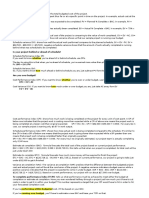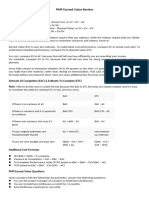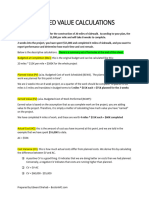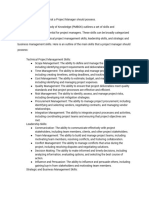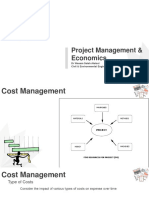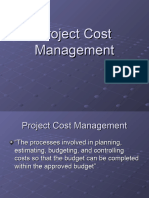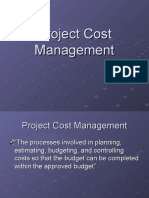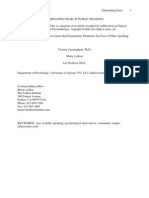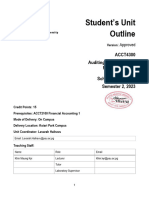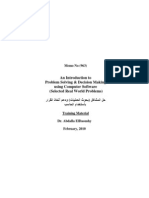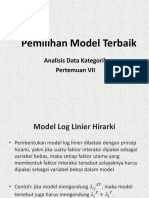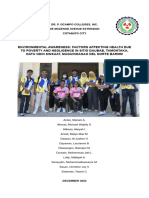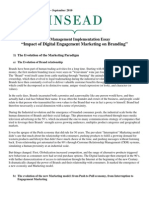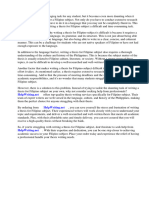OROMIA STATE UNIVERSITY
COLLAGE OF MANAGEMENT AND FINANCE
STUDIES SCHOOL OF POST GRADUATE STUDIES
DEPARTMENT OF PROJECT MANAGEMENT
Assignment on “Project Cost Management”
By
Daniel Awoke ………………. SGS/MPM/W/16/1305
Submitted to: Berhanu G, (PhD)
January, 2025
Finfinne, Ethiopia
�Q1. What are the primary processes involved in Project Cost Management, and how do they
contribute to the overall success of a project?
Primary Processes in Project Cost Management
The primary processes involved in Project Cost Management include:
Resource Planning: Identifying what resources (people, equipment, materials) are
necessary for the project.
Cost Estimation: Estimating the costs associated with the resources needed for the project.
Cost Budgeting: Aggregating the estimated costs to establish a cost baseline for measuring
project performance.
Cost Control: Monitoring the project's financial performance and managing changes to the
cost baseline.
These processes contribute to project success by ensuring that the project is completed within its
budget, helping to avoid financial overruns, and providing a framework for managing costs
effectively throughout the project lifecycle
Q2. What are the common methods used for estimating project costs, and how do you decide
which one to use in a specific project?
Common Methods for Estimating Project Costs
Common methods used for estimating project costs include:
Analogous Estimating: Using historical data from similar projects as a basis for
estimation.
Parametric Estimating: Using statistical relationships between historical data and other
variables to calculate a cost estimate.
Bottom-Up Estimating: Estimating costs for individual activities and summing them to get
the total project cost.
Three-Point Estimating: Using optimistic, pessimistic, and most likely estimates to
calculate an average or weighted average cost.
The choice of method depends on factors like the accuracy required, data availability, project
complexity, and time constraints.
1
�Q3. How do you identify and manage potential risks related to project costs? In what ways can
changes in scope impact the project budget, and how should project managers address these
changes?
Identifying and Managing Cost Risks
To identify and manage potential risks related to project costs:
Risk Identification: Conduct workshops, interviews, and brainstorming sessions to identify
risks.
Risk Analysis: Assess the likelihood and impact of identified risks using qualitative and
quantitative methods.
Risk Response Planning: Develop strategies to mitigate, transfer, accept, or avoid risks.
Changes in scope can significantly impact the project budget; for example, adding features may
increase costs. Project managers should:
Evaluate the impact of changes on the budget.
Communicate with stakeholders about the implications of scope changes.
Update the project plan and cost baseline accordingly
Q4. Assume that you are building a 4-sided fence. You estimate that the project will take 4 months
to complete and your budget is 220,000. At the end of 3 months, you are asked to prepare an
Earned Value calculation in order to determine how the project is progressing. You determine that
as of the end of month 3, total costs incurred are 190,000. and 70% of the project is completed.
Required; Compute the following:
Given Data:
Total Budget (BAC) = 220,000
Duration = 4 months
Total Costs Incurred (AC) = 190,000
Percent Completed = 70%
a) Planned value (PV)
PV= (Planned % Complete) × BAC
= (3months / 4months) × 220,000
2
� = 0.75 × 220,000
= 165,000
b) Earned value (EV)
EV= (Actual % Complete) × BAC
= 70 % × 220,000
= 0.7 × 220,000
= 154,000
c) Cost variance (CV), indicate whether the project is over budget or under budget.
CV= EV - AC
= 154,000 - 190,000
= -36,000
The project is over budget
d) Cost performance index (CPI)
CPI = EV / AC
= 154,000 / 190,000
= 0.81
e) Schedule variance (SV), indicate whether the project is over ahead of schedule or
behind a schedule.
SV = EV - PV
= 154,000 - 165,000
= -11,000
The project is behind schedule
f) Schedule performance variance (SPI)
SPI = EV / PV
= 154,000 / 165,000
= 0.93
g) Estimated at completion (EAC), determine whether the total cost of the project exceed
the original budget or not.
EAC = BAC / CPI
= 220,000 / 0.81
3
� = 271,604.94
The total cost of the project will exceed the original budget
h) Variance at completion (VAC)
VAC = BAC - EAC
= 220,000 - 271,604.94
= -51,604.94
i) Estimated to complete (ETC)
ETC = EAC - AC
= 271,604.94 - 190,000
= 81,604.94
j) How the project is progressing?
The project is currently behind schedule and over budget. With a CPI of 0.81, costs are exceeding
the budget, and an SPI of 0.93 indicates schedule delays. The project manager should analyze the
reasons for cost overruns and delays, implement corrective actions, and communicate the situation
to stakeholders to realign expectations.





